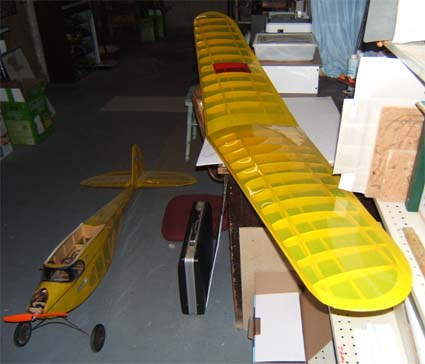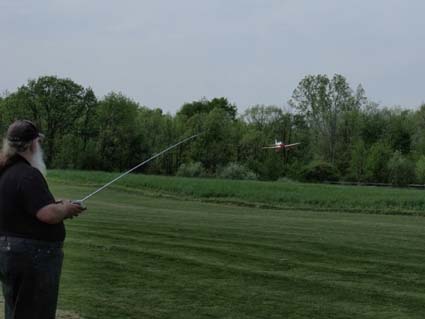 |
Flying High With Electric Power!
The Ampeer ON-LINE!
Fly the Future - Fly Electric! |
Site Table of Contents
| President: | Vice-President: | Secretary/Treasurer: |
| Ken Myers | Richard Utkan | Rick Sawicki |
| 1911 Bradshaw Ct. | 240 Cabinet | 5089 Ledgewood Ct. W. |
| Commerce Twp., MI 48390 | Milford, MI 48381 | Commerce Twp., MI 48382 |
| (248) 669-8124 | (248) 685-1705 | 248.685.7056 |
 | ||
| Board of Directors: | Board of Directors: | Ampeer Editor |
| David Stacer | Arthur Deane | Ken Myers |
| 16575 Brookland Blvd. | 21690 Bedford Dr. | 1911 Bradshaw Ct. |
| Northville, MI 48167 | Northville, MI 48167 | Commerce Twp., MI 48390 |
| 248.924.2324 | 248.348.2058 | 248.669.8124 |
| Mailed Ampeer printed subscriptions are no longer available.
The Ampeer is FREE on-line in Acrobat .pdf format and HTML with active links! | ||
| The Next EFO Meeting: Date: July 9 & 10 Mid-America Electric Flies | ||
|
From Nick Bisonni via email
Hey Ken, Continued thanks for your work on the Ampeer, which I enjoy receiving every month.
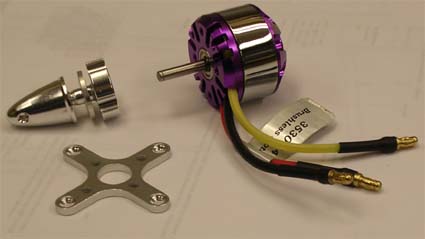 The prop diameter limitation is 8 in. (with 1-1/2 in. wheels) and I'm hoping the 3530-14 motor will perform well.
 Stay well,
The Feather Merchant and Using Drive Calculator
Ken, The Feather Merchant is an old plane from the 1936 era. The plane was built by a close friend of mine and he left it to me in his will when he passed away 10 years ago. It was built about 20 years ago and I flew it at several of our SAM events here (in Canada KM) and across the border in Michigan. It was, and still is, a majestic airplane to fly. Perfect for thermal hunting.
I got the calc program downloaded and the manual. (Drive Calculator KM) I have read the manual twice through and I am still confused. That's what happens when you hit 76.
I tried and tried to figure out stuff on the calculator for my antique Feather Merchant, a SAM plane.
Wingspan - 79.25"
I have 2200mAh Li-Polys that are 30C and a 1500mAh I use is 15C.
I want to know if what they recommend for a prop is right, or do I get a different size?
Thanks,
Hi Art, I noticed that you said that when you originally used a 12x6 prop "the motor and battery got very hot". You did not note what your amp draw was. If you do not have a power meter, you really need one. See my comments regarding power meters in the article "Electric Power Basics".
 Next, without changing anything else, select the Super Tigre .10 from the Motor dropdown menu and you will see this.  There is not the expected RPM drop due to the lower Kv of the Thrust 20, but there was an amp draw drop. Almost half of the energy going into the ESC and motor of the Super Tigre .10 is being turned into wasted heat energy. Even though the Thrust 20 shows less watts in on a power meter, it has about 20 more watts out. The increased power of the Thrust 20 can be seen by the higher RPM, which is yielding greater Static thrust for the APC 12x6E prop.
Drive Calculator (DC) is used to demonstrate what was going on. DC includes the data for the PA Thrust 20. If it did not have the data in its database, you could use a motor of similar weight and Kv. The data for the Thrust 20 was entered using information from a pretty reliable source, Dr. Kiwi. The selections used for this example: Power Supply: BlackLine 2200-35C
|
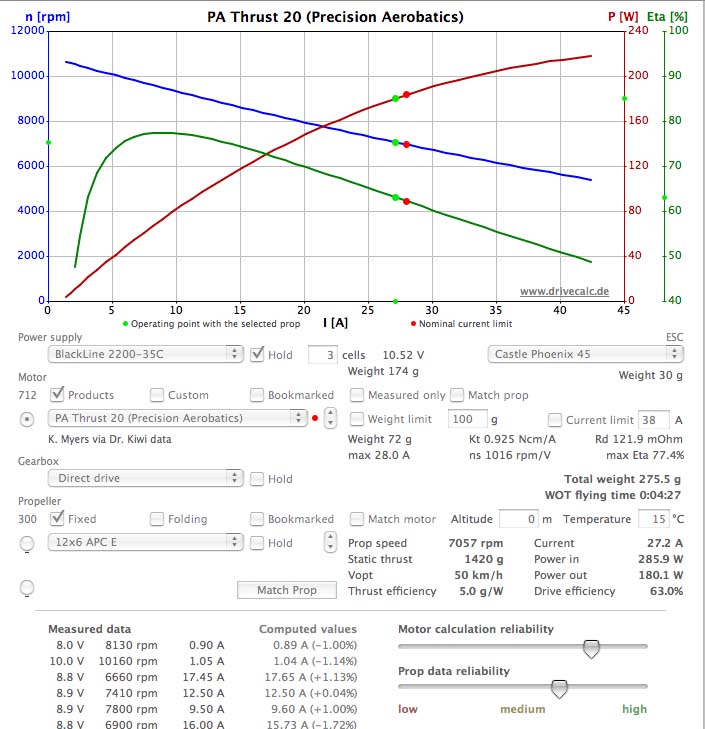
|
The lower right of the window indicates that the motor calculation and prop reliability are pretty good by the placement of the sliders along the scales for this example.
 Vopt and Thrust efficiency may or may not be useful to you. Right clicking on them will also open the converter to ounces. Current: 27.2 A shows, that according to this program, the current is above what is recommended on the PA instruction file, but not above the max set in the program of 28.0A. Power in: 289.5 W is the approximate voltage shown next to the battery choice 10.52 V * 27.2 A. This is getting pretty near the PA recommended watts in for this motor. Power out: 180.1 is calculated by the electrical and mechanical losses that the program predicts for this motor. Drive efficiency: 63.0% is basically the predicted Power out divided the predicted Power in at the ESC. 63% is pretty typical for these small outrunners at relatively high amp draws. Hopefully, you can see why when using a 12x6, your motor was running 'hot'.
Current: 21.4 amps
Drive Calculator may also be used to select or match a power system to an airframe and its mission, but you do need to know a few things about airframe and mission.
 The power chart does not show old-timers, but they really need no more power for their mission than park flyers or slow flyers. That is 50 watts in to 60 watts in per pound of motor weight. At 60 watts in * 4.5 lb. that would be 270 watts in. For ease in talking numbers, 300 watts in is good. Your power system choice was good for the watts in for this plane's mission.
|
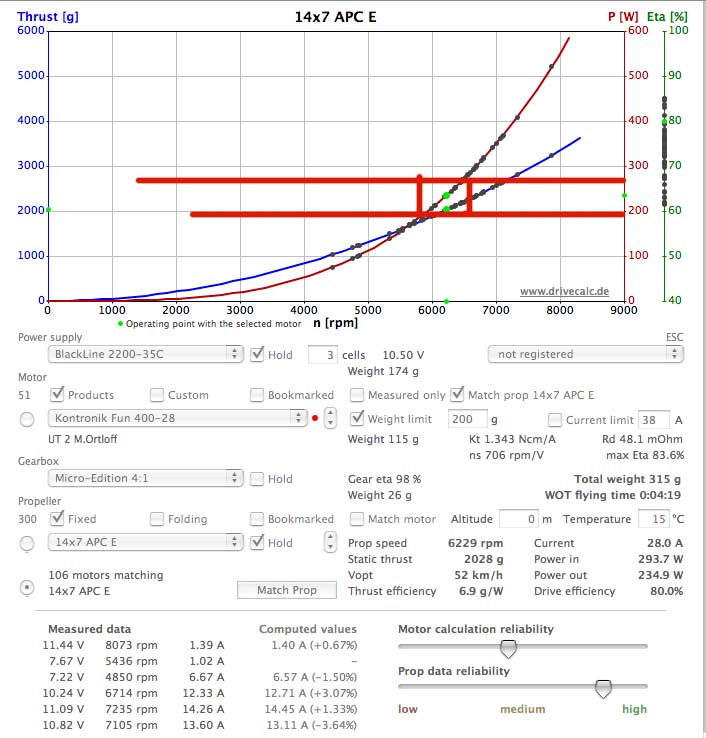
|
When selecting motors using a given prop and battery, DC will present a very large number of possible motors. There are so many that it is almost overwhelming. To limit the number of motors, if the input watts can be guesstimated, in this case 300, divide that by 1.5. You can call the 1.5 a constant if you like, although it is based on something. To limit DC to motors weighing 300 watts in / 1.5 or 200g, check the box Weight limit next to the motor choice box and type 200 in the box to the right of the check box.
AXI 2826/12 181g, 300.0 watts in, 28.6 amps, 71% eff. Kontronik Kora 15-16 152g, 302.5 watts in, 28.8 amps, 76.5% eff. The Kontronik Kora 15-16 looks like a good candidate with the lightest weight and best efficiency. The $199.00 price might be a deterrent to you. www.icare-rc.com/kontronik.htm
If it is, click the radio button next to the 14x7 APC E drop down selection box. Click on the check box above the 200 g motor weight limiter box to deselect it.
AXI 2826/12 178g, 281.9 watts in, 26.8 amps, 79.7% eff. Scorpion SII-3014-830 15-deg 129g, 31.9 amps, 70.2% eff. Kontronik Kora 15-14 155g, 297.2 watts in, 79.5% eff. The motor of choice here, would be the Kora 15-14, which is the same price as the -16 version.
EMAX BL2815-09 112g, 276.8 watts in, 26.3 amps, 78.1% eff. EMP C4240/10 890Kv 140g, 274.2 watts in, 26.0 amps, 76.3% eff. Torque 2814T-820 143g, 273.2 watts in, 25.9 amps, 75.2% eff. EMAX BL2820-07 145g, 323 watts in, 30.9 amps, 73.1% eff. E-flite Power 15 BL Horizon Hobby 152g, 342.2 watts in, 32.9 amps, 80.0% eff. Turnigy TR 35-48-B 900kv 161g, 308.2 watts in, 29.4 amps, 68.9% eff. Turnigy TR 35-48-B 900kv #2 170g, 291.0 watts in, 27.7 amps, 77.3% eff. Hacker A30-10XL 177g, 313.7 watts in, 30.0 amps, 82.1% eff. E-flite Power 25 BL (5-deg timing) 190g, 305.6 watts in, 29.2 amps, 76% eff. At first the EMAX BL2815-09 at 112g looks like it might be a good choice, but Motor calculation reliability is low.
AL = Art Lane
AL: Well, good results now. I ran the test again after getting the 11x5.5E prop and here's what I found
Li-Poly at start 12.04V (Didn't put it on charge after Fridays tests)
KM: Yes, the efficiency of about 67.6% is about as good as you can get with a good size prop diameter on the Thrust 20.
AL: I tested, again, my FM setup. The RPM of the present setup, APC 11x5.5E, on the Thrust 20 was higher than the calc program gave. I read 7200 RPM and again, got a little alarmed. KM: Calculator programs aren't perfect. They will give results close enough, but not 100% accurate. You'll get a bit better results by setting your altitude and the temperature in Drive Calculator. The boxes to enter them are down about 2/3 of the way on the right side of the program window. 7200 RPM yields a pitch speed of 37.5 mph. Good for this type of plane. Drive Calculator is a useful program for doing 'what ifs'. At the price, FREE, it should be on everyone's computer and it runs on all the popular operating systems. Keith Shaw Maidens the Yak UT-1
Keith Shaw maidened his Toledo winning Yak UT-1 at the Midwest field. Here's what he had to say about it. KM May 21st: Just returned from a successful test flight with the Yak UT-1 that I built for Toledo. Actually it has been a long time coming as I started it three years ago, but for the two previous Toledo Shows, emergencies always came up to prevent me from finishing it.
Keith The 2011 Mid-America Electric Flies Information The 2011 edition of the Mid-Am will take place on July 9 & 10. For more information: Hotel list and map to flying field |
To Reach Ken Myers, you can land mail to the address at the top of the page. My E-mail
address is:
KMyersEFO@mac.com
EFO WEBsite: http://homepage.mac.com/KMyersEFO/

